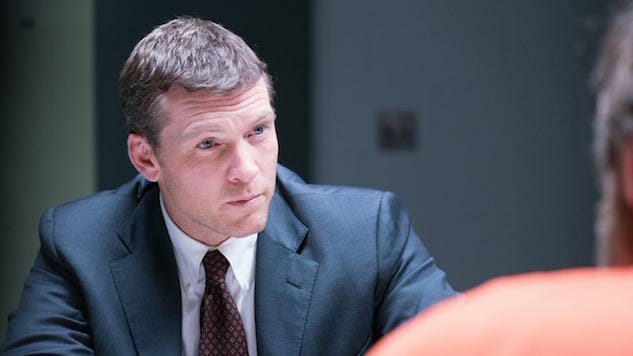Manhunt: Unabomber, The Silence of the Lambs and Our Enduring Obsession with Criminal Profilers
Photo: Discovery Channel
Criminal profiler James “Fitz” Fitzgerald (Sam Worthington) enters his quarry’s cell carefully, as if he’s afraid a sudden movement will set the Unabomber off. Ted Kacyznski (Paul Bettany) has already requested his presence, and under pressure from his former FBI colleagues, fearful that a public trial offers a bullhorn to a terrorist, Fitz agrees to secure a guilty plea. In the two-part premiere of Discovery Channel’s Manhunt: Unabomber, he sidles up to the subject slowly; he flatters Kaczynski’s intelligence, reprising his role as the man’s worst enemy and only friend. Still, he triggers the trip wire: After Fitz’s ham-fisted mention of the agreement, Kaczynski turns to address the agents watching from an adjacent room. “And he was doing so well,” he clucks.
“Ham-fisted,” of course, is the term Hannibal Lecter (Anthony Hopkins) uses when he sniffs out Clarice Starling (Jodie Foster), her ulterior motive’s top note as fragrant as Evian skin cream or L’Air du Temps. Their first encounter in Jonathan Demme’s The Silence of the Lambs (1991) is the template for Fitz and Kaczynski: the cautious approach, the courteousness, the connection established and severed in turn. Introducing her questionnaire, Clarice fumbles, too, though in Demme’s hands (and Hopkins’), the moment carries an unmatched charge. “No, no, no, no, no,” Lecter says, framed in one of the film’s exacting close-ups. “You were doing fine.”
The distance between the two sequences—piercing original and half-blurred facsimile—begins to explain Manhunt’s main misstep. Created by Andrew Sodrowski, the miniseries toggles between 1995, when Fitz, fresh from Quantico, comes onto the case, and 1997, when he’s brought in from a remote cabin to confront Kaczynski again. In the meantime, it’s clear, his obsession with the Unabomber has caused explosions of its own: His wife (Elizabeth Reaser) and children are absent, and his isolation bears a resemblance to Kaczynski’s. “Nobody even tries, nobody except for Ted,” Fitz says admiringly, leaving unmentioned the consequences of that effort—a 17-year mail bombing campaign that killed three people and injured 23 more, an unreadable treatise on his anti-technological anarchism, and a few self-aggrandizing letters to the Times. In this bifurcated structure, Manhunt aims for a portrait of a profiler so in tune with the man he’s profiling that he loses himself in the process, though in effect the series’ understanding of Fitz—and his relationship to Kaczynski—runs no deeper than the mirror image it presents. Unaided by Worthington’s square, stoic blankness, Manhunt’s protagonist is merely a cipher, as thin as the dossier he’s handed when his investigation begins.
In his 2007 feature on criminal profiling—which starts, fittingly enough, with a serial bomber—The New Yorker’s Malcolm Gladwell writes, “We are now so familiar with crime stories told through the eyes of the profiler that it is easy to lose sight of how audacious the genre is… The profiler sifts through the case materials, looks off into the distance, and knows.” The insight of The Silence of the Lambs is that it’s not so simple. In that magnificent first exchange, Lecter’s astute reading of Clarice emerges, for instance, from a thicket of specifics—her scent, her bag, her shoes, her barely hidden accent—which Demme then animates, and reshapes, through his abundant use of the first-person perspective. As the camera scans the faces of policemen at a funeral parlor, or as the film flashes back to Clarice’s childhood, our point-of-view mimics hers; the search for the murderous Buffalo Bill reaches its climax in a night-black basement, the sequence’s masterly suspense built from her blindness. It’s not, after all, a flash of inspiration that leads Clarice to Bill’s doorstep, or to realize that she’s caught the killer at home—it’s the care with which she follows leads, conducts interviews, uncovers connections among the clues that others might have missed. In The Silence of the Lambs, “profiling” is another word for “understanding,” whether applied to our heroine, her interlocutor, or her antagonist: Neither the film nor the case it depicts hinge on empathetic magic, because Demme, the consummate director, recognizes watchfulness as a form of work.